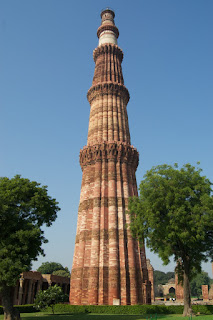It is believed that Qutubminar was built by Qutubdin. However there are various point that prove that it was built much earlier :
Stones dislodged from the Qutubminar have Hindu images on one side with Arabic lettering on the other. Those stones hare now in Museum. The claim is that Muslim invaders used to remove the stone- dressing of Hindu buildings, turn the stones inside out to hide the image facial and inscribe Arabic lettering on the new frontage.
There are pieces of Sanskrit inscriptions that can still be deciphered in the premises on numerous pillars and walls. Sanskrit inscription means it was built by Hindu King.
Entrance to the tower faces north and not the west. Building built by Hindu Kings are north or east facing. Most of building built by Muslim kings are west facing
On each side of entrance is the stone lotus flower emblem which denotes that it was built by Hindu King. The stone flowers denotes it was built by Hindu emperor in mediaeval timeframe. Muslims King never use such flowers on the buildings
Qutubminar is next to an area called Mehrauli. Mehrauli is Sanskrit word made of Mihira-awali. r Mihira of Vikramaditya's court was a famous astronomer lived along with his helpers, mathemati- cians and technicians. They used this tower as an observation post for doing astronomical study. Around the Qutubminar tower were pavilions dedicated to the 27 constel- lations of the Hindu Zodiac.
Because of all these factors many people believed that Qutubminar was built much earlier by a Hindu King. Later when Muslim emperor ruled Ind, they changed the stone and made it todays' Qutubminar.
Many authors have written and mentioned The pillar in Qutubminar, that weighs more than six tons, is said to have been made at the time of Chandragupta Vikramaditya (375�413), though other authorities give dates as early as 912 BCE. The pillar initially stood in the centre of a Jain temple complex housing twenty-seven temples that were destroyed by Qutb-ud-din Aybak, and their material was used in building the Qutub Minar and Quwwat-ul-Islam mosque. |





No comments:
Post a Comment